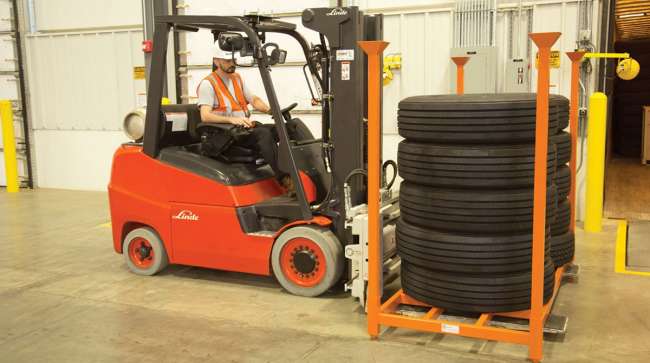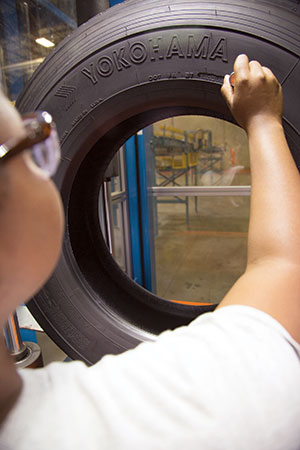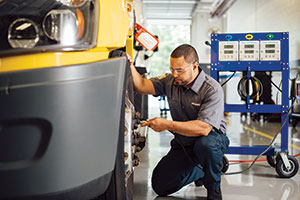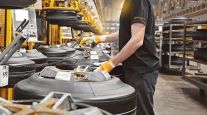Special to Transport Topics
Tire Manufacturers Remain Cautious About Finding Supply Chain Solutions

[Stay on top of transportation news: Get TTNews in your inbox.]
Commercial tiremakers are feeling a different type of March Madness dealing with their supply chains. Industry experts trace the start of the supply chain woes to March 2020 and the start of the COVID-19 pandemic, causing the shutdown of manufacturing plants and the further thinning of already tight labor markets.
Today, as COVID variants and restrictions recede, new external shocks are slamming the supply chain, most recently Russia’s invasion of Ukraine, which affects tire production in both of those countries plus the European Union. Rising inflation and interest rates, plus increases in oil, diesel and gas prices, have also added to the supply chain calculus, especially in the tire industry.
Industry analysts and executives offer a broad range of views on the impact of bottlenecks in the supply chain and how to work through the pain points for the benefit of their customers in this critical global industry.

Gust
Dick Gust, the new CEO of the Tire Industry Association, said the supply problems were having a negative impact on tire sellers while they were experiencing double-digit sales increases, year-over-year.
“The real dilemma is that the lack of tire supply touches every industry,” Gust said. “In 2020 and 2021 when people decided to drive versus flying because of the pandemic, we couldn’t produce tires fast enough.”
The U.S. Tire Manufacturers Association (USTMA) said March 1 it projects total U.S. tire shipments of 340.2 million units in 2022, compared to 335.2 million in 2021 and 332.7 million units in 2019. Original equipment shipments for truck tires are expected to increase 6.3% this year while shipments for replacement truck tires is expected to increase by 1%, according to USTMA. Meanwhile, the production of trucks and trailers has been restricted for over a year as certain parts and components are in short supply.
“The severity of shortages is ever-changing and varies from week to week,” said Don Ake, vice president of commercial vehicles for FTR Transportation Intelligence. “Tires, for example, were in short supply at the beginning of the crisis, got better, and now are tight again.”
Ake noted that OEMs have been carefully managing the situation, “but there is pain all around.” He forecasted the supply chain situation may improve in trucks in Q3 2022 and in trailers in Q2 2022.
Tire Industry Still Cautious
In a report released by Yokohama Tire Co., company executives gave a frank assessment of the tire industry, including, supply chain pain points and where they exist. Jeff Barna, president and CEO, said he feels projections for a return to normalcy in 2022 might be too optimistic. He cited both macro and micro factors for the foreseeable future as delaying a “business-as-usual” climate to sometime next year.

Analysts say inflation plus the rising costs of freight and fuel are resulting in higher prices. (Yokohama)
He pointed to the macro factor side of the equation that 85-plus steamships anchored off the Port of Long Beach are “only the tip of the macro iceberg.”
“Understanding the micro factors building up to this backlog would require a deep analysis (and recovery projections),” he said.
Barna listed the micro factors disrupting the tire supply chain as: microchip shortages, plant shutdowns, labor unrest at ports, driver shortages, excess container complications, potential freight company arbitrage, plus market supply and demand.
“The point here is that even if some or most of these issues are remedied in the near future, it will likely be 2023 before realignment of all variables is achieved,” he said.
Todd Fowler, managing director and equity research analyst for KeyBanc Capital Markets who covers the transportation industry, said the supply chain congestion for the commercial truck market is “real and pervasive, especially what it’s doing to work through the supply chain.”

Fowler
The root cause of the supply chain dilemma, he said, “stems from labor availability on loading and unloading trailers since COVID put laborers out of service and they were unable to quickly turn equipment at distribution centers.” He said inflation plus the rising costs of freight and fuel result in higher prices for customers.
“Fleets have to pass-through rising costs to customers,” he said. “The effects of inflation are well known, and people realize they have to pay more.”
Fowler said last year fleets had higher costs because drivers’ wages increased to address an ongoing labor shortage.
“Freight demand is positive, but the big impact on cost to fleets is inflation, equipment and components,” he said. “Inflation impacts equipment and OEMs are struggling to get orders filled.”
Despite the kinks in the supply chain for the past two years, fleet companies feel that the tire OEMs are working through those supply chain issues.
Penske Truck Leasing services more than 365,000 trucks, a significant portion of which are Class 8 vehicles. Penske’s customers typically lease anywhere from one to 1,000 trucks.
Tire maintenance of the Penske fleet is part of the preventive maintenance service that Penske Truck Leasing provides for its customers. The impact of supply chain issues on Penske Truck Leasing and its customers in the last two years has been minimal, according to Paul Rosa, senior vice president of procurement and fleet planning.

To remedy supply chain issues, Penske has kept a substantial mounted tire supply in stock at its facilities. (Penske)
Penske Logistics ranks No. 14 on the Transport Topics Top 100 list of the largest for-hire carriers in North America, and No. 18 on the TT Top 50 logistics carriers list.
“For the last two years, tire OEMs have done a tremendous job in keeping the supply flowing,” he said. “Customers have had minimal impact due to the amazing efforts of the tire OEMs. Customers understand that at any given time there may be some delays.”
To service their huge fleet of trucks and mitigate any delays along the tiremakers’ supply chain, Rosa said Penske keeps a substantial number of mounted tires in stock at its facilities. “We have a significant amount of supply that is always in motion,” he said.
Sourcing Materials
Another factor in the tire supply chain is the sourcing and cost of raw materials to produce the tires. Gust said the basket of materials that goes into producing a tire was nearly 25% higher in 2021 than 2020.
“The carbon black and crude oil that goes into the making of tires was up 23% from November 2020 to November 2021,” he noted. “This year it’s already up 9%.”
Yokohama said the sourcing and supply of raw materials has been consistent, but the timing of deliveries of raw materials has lagged.
“On occasion, there has been an increase in the amount of time it takes to receive delivery of some of these materials,” said Andrew Briggs, the tire manufacturer’s vice president of marketing and product management. “There has not been any lost production, but we continue to monitor the situation closely.”
Gust said the tire manufacturers are looking for sustainability in raw materials. He mentioned that they are experimenting with materials that reduce the amount of oil needed to make tires.
“Fluctuating oil prices cause volatility, added expense and that’s not sustainable,” Gust said. “Rolling-resistance tires are in the forefront of the discussion because of the rise in gas and diesel prices. Manufacturers have to decide how to lessen the performance trade-offs of rolling-resistance tires.”
Cost Concerns
Fleets and tiremakers are also dealing with price increases for materials and freight expenses, while fuel and labor costs continue to rise.
“Fleets are impacted in real time on rising fuel costs but can use fuel surcharges to help recover the increase in fuel expenses,” said Fowler. “The big impact of ‘pass-through pricing’ for freight charges will be felt when consumers begin to pull back on spending.”
Yokohama says its prices have increased due to the cost of raw materials, inbound and outbound freight expenses, and other operational costs.
“Since we cannot simply pass on all of this unfavorability in the form of price increases, we have to control our internal expenses and maximize returns across all areas of our business,” said Briggs.
In the last two years, Penske has seen the supply of tires tighten.

Rosa
“While tire surpluses are not as great (today) we have not had any significant delays,” Rosa said. “We are seeing price increases for tires.”
While fleets need to pay attention to the availability and the cost of tires, the major pain point for tiremakers is the backlog or the potential for a delay in delivery.
“Every industry seems to be facing similar issues,” said Briggs. “We have been successful at mitigating any production or supply interruptions through careful planning and production scheduling.”
While tire demand is forecast to remain strong this year in both the commercial and consumer tire markets, Yokohama sees an emphasis on existing trends in both markets.
“Commercial fleet operators will continue to place a premium on tires that deliver the lowest total cost of ownership, while exploring integrated digital solutions like sensors to monitor their fleet’s performance,” said Stan Chandgie, executive vice president of sales at Yokohama. “Additionally, demand will continue to increase for light-truck commercial tires as the rapid expansion of e-commerce and final-mile delivery services endures.”
Want more news? Listen to today's daily briefing below or go here for more info:




